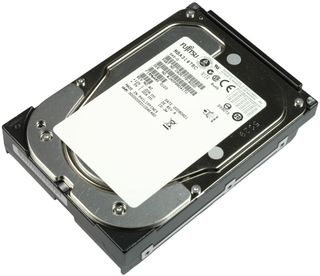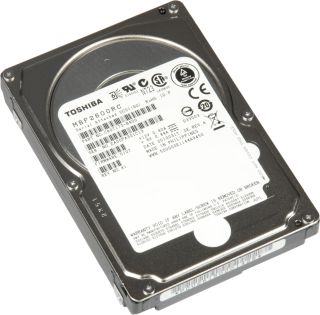Changing Of The Guard: 2.5” Hard Drives In The Enterprise
2.5” Vs. 3.5”: Drive Examples
First off, it’s important to know that 2.5” enterprise hard drives have more z-height than consumer drives. The latter are available at 9.5 mm (notebooks) or 12.5 mm (portable storage), but all enterprise drives require 15 mm height. This is becase they usually need to accommodate three physical platters. This is also true of 2.5” 12.5 mm products, but the increased spindle speeds of 10,000 or sometimes 15,000 RPM have to be managed. Also, know that the platters inside of 2.5” and 3.5” enterprise hard drives actually have the same diameter, which tells us that the main advantage of 3.5” over 2.5” is the capacity to hold four or more platters. Clearly, it’s all about maximum capacity, which, as we said, isn’t the domain of these enterprise drives.
3.5”: Fujitsu MBA3147RC (15,000 RPM, 147GB)

We're using Fujitsu’s MBA3147RC for this form factor comparison. This drive is a good example of a conventional 3.5” high-performance enterprise HDD. It comes with a 16MB buffer, SAS 3Gb/s interface, and 1.4 million-hour MTBF. Toshiba, which acquired Fujitsu last year, isn’t going to deliver a 600GB, 3.5” hard drive, and as a result, the MBA series ends at 300GB. Other popular products are Hitachi’s Ultrastar 15K series and Seagate's Cheetah 15K. We need to say that other, newer 3.5” 15,000 RPM drives reach much higher throughput, but I/O performance has remained unchanged because read and write heads cannot be accelerated indefinitely. There are physical limits. Expect faster 3.5” drives to deliver 150 to 200 MB/s.


2.5” Toshiba MBF2600RC (10,025 RPM, 600GB)

This is one of the newest 2.5” enterprise hard drive products. The MBF series by Toshiba offers up to 600GB in a 2.5” form factor. It’s one of the early SAS 6Gb/s drives, hence it offers twice the interface performance of its predecessor. In the real-world, however, this is a fairly minor point, as performance from the platters doesn’t exceed 147 MB/s. The drive offers more throughput than our 3.5” Fujitsu comparison drive, but it wouldn’t stand a chance against the latest 15,000 RPM drives with regard to throughput. I/O performance is mainly determined by the rotation speed and the resulting rotational latency. Similar products are available from Hitachi (C10K300) and Seagate (NS.2), but only Seagate and Toshiba are currently shipping 600GB capacities.


Stay on the Cutting Edge
Join the experts who read Tom's Hardware for the inside track on enthusiast PC tech news — and have for over 25 years. We'll send breaking news and in-depth reviews of CPUs, GPUs, AI, maker hardware and more straight to your inbox.
Current page: 2.5” Vs. 3.5”: Drive Examples
Prev Page Flash Everywhere? Next Page 2.5” Vs. 3.5” Performance And PowerMost Popular

